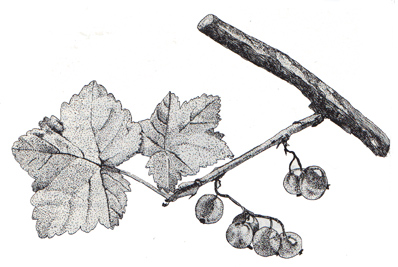

Current
Ribes species
(Grossulariaceae)
Description:
The genus Ribes, with seventy-five
species in North America, includes the currants and the gooseberries. These
shrubs have maplelike leaves. The berries are black to purple with gland-tipped
hairs (R. lacustre, swamp gooseberry or swamp currant),
glandular with a whitish to bluish bloom and fetid odor (R. bracteosum,
the stink currant), black and bitter with resin dots (R. hudsonianum,
the skunk currant), black with bluish bloom and gland-tipped hairs (R.
laxiflorum, the trailing black currant), or translucent and
red (R. triste, the American red currant).
Usually the flowers and berries are borne in drooping racemes. The small flowers have a tubular base with five sepals larger and more conspicuous than the five scalelike petals, and five stamens alternate with the petals.
Distribution:
The only places in Alaska that do not contain some type
of currant are the extreme northern and western coasts and the Aleutians.
Medicinal Uses:
According to Kari, the stem of R.triste is medicine
for colds, flu, and tuberculosis. First scrape off the outer bark and throw
it away. Then boil the inner bark and stem together. Drink the tea. Also, cooled
tea is a warm wash for sore eyes. De Laguna reports similar use by the Mount
Saint Elias people.
According to Kirk, the berries of R. cereumwere used by the Hopi Indians to relieve stomachaches. And from the European herbalists, as noted in Simmonite-Culpeper, the jelly made with the juice of R. vulgaris is "cooling and grateful to the stomach" and cooling in fevers.
Washington state natives have many medicinal uses for Ribes, described by Gunther. Roots of the common gooseberry, boiled into a tea, are drunk by the Swinoiflish for sore throats, tuberculosis, and venereal disease. The bark is soaked to make an eyewash. The Cowlitz burn and pulverize the woody stem and rub the charcoal on sores on the neck. Bark of the swamp gooseberry or swamp currant, R. lacustre, is peeled off and boiled into a tea to drink during labor or to wash sore eyes. The Lummi make tea from the twigs for general aches. Bark, leaves, twigs, and roots of the trailing black currant, R. laxiflorum, were used to make medicinal tea for colds.
Note: The blister rust fungus that kills the white pine and other five-needle pines requires Ribes for part of its lifecycle. In eradication efforts many currant plants have been destroyed.
Copyright © 1987 by Eleanor G. Viereck